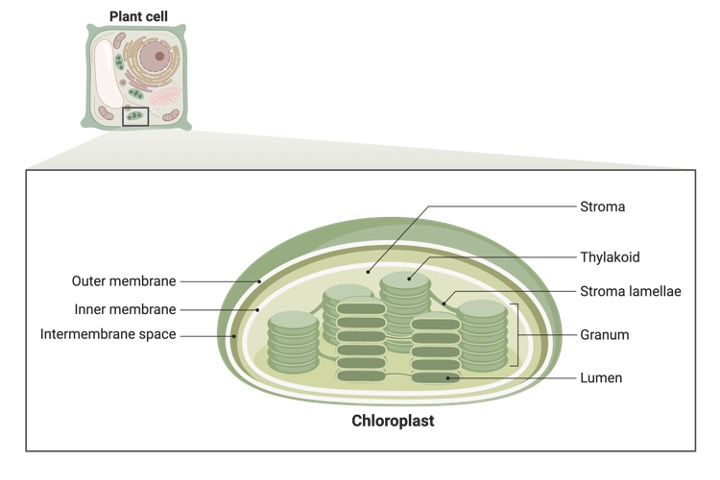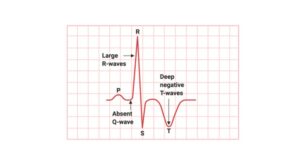Table of Contents
Chloroplast Definition
Chloroplast is an organelle found in the cell of photosynthetic eukaryotes that is filled with the green pigment called ‘chlorophyll’. The word chloroplast is derived from two Greek words, ‘chloros’ (green) + ‘plast’ (form/entity). Chloroplastid, green plastid, and chloroleucite are synonyms of the chloroplast.
What is Chloroplast?
The presence of chloroplast in a eukaryotic is an indication of the organism’s capacity to produce its food via the process of photosynthesis. Plants are the prime example of organisms that possess chloroplasts inside their cells.

The physical appearance of their cells itself is the indication of the presence of chloroplast that is spread throughout the cytoplasm. Chlorophylls are the light-harvesting systems present in chloroplast. They are green pigments that absorb blue and red light of the electromagnetic spectrum and they reflect the green light due to which plants are green.
Animal cells do not consist of chloroplasts. Thus, the presence of chloroplast is another distinct characteristic apart from the presence of a cell wall, that helps us to differentiate between plants and animals.
Apart from plants, eukaryotic algae possess chloroplasts, e.g., green algae. Phototrophic bacteria and cyanobacteria have chlorophylls in their cells, hence they are photosynthetic. In such bacteria, however, the chlorophylls are not found inside the chloroplast, rather they are located in the thylakoid membrane.
Characteristics of Chloroplast
Chloroplast is a type of plastid. It is found in photosynthetic eukaryotic cells. The chloroplasts can be distinguished from the other plastids like chromoplasts and leucoplast based on their color, structure, shape, and function. The chloroplasts are green due to the presence of abundant chlorophyll pigments.
Chlorophyll a and b are the two main types of chlorophyll. Chlorophyll a is found in all chloroplasts. Chlorophyll b and other chlorophyll pigments like c, d, and f are present in varying amounts depending on the species.
In vascular plants, the size of chloroplast is approx. 5µm in length and ~2.5µm in width while its shape resembles a lens or a disc. In algae, the shape could be round, oval, or tubular.
Structure of Chloroplast
The chloroplast has three membrane systems:
- outer membrane,
- inner membrane
- thylakoid system
The typical feature of an organelle is the presence of the double membrane i.e., the outer and the inner membrane. Harvesting or collecting photons from a light source i.e., sunlight is the function of disc-shaped structures called thylakoids.
The antenna complex comprising of proteins, and light-absorbing chlorophyll and carotenoids, and some other pigments are embedded in the thylakoid membrane. Hence, thylakoid provides a site for photosynthetic light reactions.
The stack of thylakoids called granum (plural: grana) resembles a stack of a coin. Stroma, the thick fluid in between grana containing enzymes, molecules, and ions, is the matrix of the chloroplast. Stroma is the site for the dark reaction of photosynthesis, wherein the light-independent process of sugar formation occurs.
Similar to the mitochondria, chloroplasts have their own DNA, hence they are semi-autonomous organelles. This DNA is referred to as chloroplast DNA or cpDNA. They produce certain proteins from their own DNA without relying on the genes contained in the nucleus.
Chloroplast Functions
The main role of chloroplast is photosynthesis i.e., it is a site for light and dark reactions. These organelles are important to photosynthetic organisms because inorganic sources like water and light energy are converted into sugar molecules i.e., glucose through these organelles.

Via these processes, photosynthetic organisms can produce their own food and do not need to feed on other organisms. Chloroplasts are crucial for producing oxygen – a byproduct of photosynthesis, which is late released into the environment. In animals, various biochemical and physiological processes require oxygen.
Chloroplast Evolution
The origin of chloroplast is described via the Endosymbiotic theory. Millions of years ago, as a result of primary endosymbiosis between the eukaryotic host cells and the primary endosymbionts, organelles such as chloroplasts and mitochondria emerged in eukaryotic cells.
Photosynthetic prokaryotes e.g., cyanobacteria were engulfed by the eukaryotic cell, enabling the eukaryotic cell to photosynthesize. Inside such eukaryotic cells, the prokaryotes eventually evolved and differentiated into chloroplasts and other plastids.
Such photosynthetic eukaryotes are presumed to be ancestors of algae and modern plants. This theory is supported by the discovery of cpDNA, similarity in membranes, and reproduction by binary fission.
Chloroplast Citations
- Efficient photosynthesis in dynamic light environments: a chloroplast’s perspective. Biochem J . 2019 Oct 15;476(19):2725-2741.
- Chloroplast genomes: diversity, evolution, and applications in genetic engineering. Genome Biol . 2016 Jun 23;17(1):134.
- Chloroplast ultrastructure in plants. New Phytol . 2019 Jul;223(2):565-574.
- Figures are created with BioRender.com













